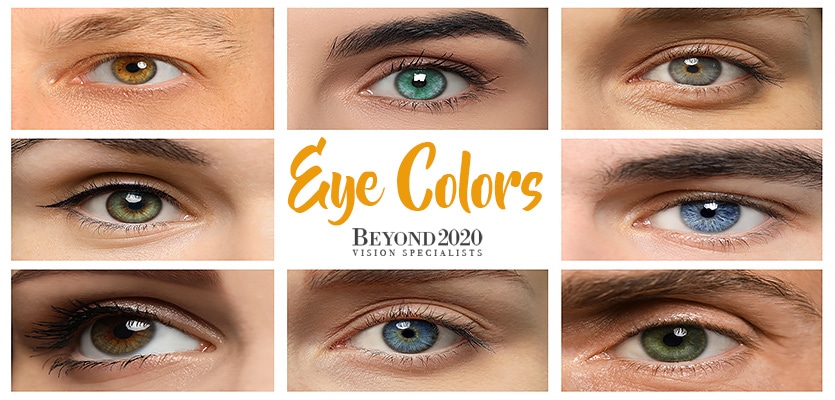How Is Eye Color Determined?
Home » How Is Eye Color Determined?

How Is Eye Color Determined?
Did you know that you’re the only person in the whole world with your exact eye color? The color of other people’s eyes may look identical to yours, but there will always be a difference. It’s a little bit like DNA and fingerprints. Your DNA may be extremely close to that of a sibling, but it will never be exactly the same. Where did you get the color of your eyes? Did it come from your parents, or were other factors involved? Does the color of your eyes affect your vision or the likelihood that you may develop eye problems? To answer these questions, here is some information on how eye color is determined:
What Part of the Eye Is Colored?
The part of the eye that is colored is the iris. If you look in a mirror, you will notice what appears to be a small, black circle in the middle of your eye. That is the pupil. Although it looks black, the pupil is actually a hole that lets light into your eye in much the same way that a camera lens operates. The iris is the part of the eye surrounding the pupil. The iris functions like a camera diaphragm to control the amount of light that enters the eye by adjusting the size and shape of the pupil. It does that by using the sphincter pupillae muscle to contract the pupil and the dilator pupillae muscle to dilate the pupil. The iris is surrounded by the white part of the eye known as the sclera.
Where Does the Iris Get Its Color?
The iris is composed of layers that contain melanin pigment. Eyes with a higher concentration of melanin will be darker in color, and eyes with less melanin will be lighter in color. Irises with a lot of melanin pigment will be brown, but the shade may range from light brown all the way to black. Irises with a medium amount of melanin pigment will be green or hazel. Irises with very little melanin pigment will be blue. While some babies are born with brown eyes, many babies are born with blue eyes because their bodies have not yet developed enough melanin pigment to color their eyes. That process can take as long as two to three years in some cases.
Do You Get Your Eye Color from Your Parents?
In the past, it was commonly believed that you get your eye color solely from your parents and that a single gene was responsible for your eye color. Under that theory, it was believed that two blue-eyed parents could not have a brown-eyed child. However, modern science has shown that the process of determining eye color is much more complex than previously thought. Yes, the color of your parents’ eyes does have a bearing on the color of your eyes, but your eye color also depends on the interaction of more than a dozen genes, and it is possible for two blue-eyed parents to have a brown-eyed child.
Which Parent Determines Eye Color?
Although we now know that many factors influence the color of a person’s eyes, we can still rely on genetics for a basic understanding of the parent’s role in determining eye color. Darker colors are dominant, and lighter colors are recessive. Brown is the most dominant, and blue is the most recessive. Green and hazel are recessive to brown but dominant to blue. The parent who has the most dominant eye color is the parent most likely to determine a child’s eye color. If both parents have brown eyes, there is a 75 percent chance that their children will also have brown eyes. If only one parent has brown eyes, there is still a 50 percent chance that their children will have brown eyes.
What Are the Pigments That Produce Eye Color?
There are three pigments that produce eye color: melanin, pheomelanin, and eumelanin. Here is some information about each:
Melanin
Melanin is a pigment that can be found in a person’s skin and eyes. It is brown in color and produces various shades of brown eyes. It is also responsible for a wide array of skin tones.
Pheomelanin
Pheomelanin is a reddish pigment that gives some people red hair and a reddish or red-orange skin tone. When irises contain a significant amount of pheomelanin, their eyes are typically green or hazel.
Eumelanin
Eumelanin is a very dark brown color that gives some people their black eyes and darker skin tones. It also plays a role in determining color intensity.
What Eye Color Is the Rarest?
Green eyes are the rarest and are present in only about two percent of the world’s population. The reason a person’s eyes look green has to do with a limited amount of melanin plus the way that their irises reflect light. Brown eyes are the most common and are present in more than 50 percent of the world’s population. Occasionally, a person will have eyes with different colors. This condition is known as heterochromia. Such a condition can be present at birth, but it can also develop later in life.
Why Do Eye Colors Change Throughout Your Life?
There are several reasons why your eye color might change throughout life. These reasons include aging, medicines, and certain health conditions, such as those listed below:
Trauma
In some cases of eye trauma, the iris loses tissue that contains melanin. When that happens, a person’s eyes may take on a slightly different color.
Neurofibromatosis
Neurofibromatosis is a nervous system disorder that can cause small bumps to appear at various locations on the body. It can also produce small growths on the iris known as Lisch nodules. While these nodules are mostly harmless, they can affect the color of the iris.
Uveitis
Uveitis is a type of inflammation that affects the middle tissue in the eye known as the uvea. Not only can uveitis produce a change in color, but it can also cause swelling and a possible loss of vision. There is also a chronic form of uveitis known as Fuchs’ heterochromic iridocyclitis that can lead to multiple eye problems, including a change in color.
Horner’s Syndrome
Horner’s syndrome results from nerve damage that is typically caused by a stroke or spinal cord injury. It can cause the iris to lose pigmentation, plus it can constrict the pupil and cause the eyelid to droop.
Albinism
This condition results from the absence of melanin in a person’s skin and eyes. Not only does the amount of melanin in a person’s eyes help to determine their eye color, but melanin also plays a part in the development of the optic nerve. For this reason, some people who suffer from albinism have problems with their vision.
Cataracts
Although cataracts do not directly affect the color of the iris, they tend to cloud the lens located behind the pupil, giving the eyes a cloudy or milky look. Cataracts can degrade a person’s vision, especially in older adults. Fortunately, most cataracts can be treated through modern surgical techniques.
Are Some Eye Colors More Sensitive to the Sun than Others?
In addition to providing your irises with color, melanin also helps to protect your eyes from the sun. Other things being equal, people who have brown eyes are more protected from the sun than people who have blue eyes because brown eyes contain more melanin. However, you should always protect your eyes from the sun regardless of their color. Be sure to wear a high-quality pair of sunglasses that provide protection against harmful UV rays. If you have any doubt about the best type of sunglasses to wear, you should check with your optometrist.
Seek the Advice of an Eye Expert
If you have any concerns about your eyes, including their color, contact Beyond 2020 Vision Specialists today so that we can schedule an appointment. Dr. Christopher Tumolo is an expert in all types of eye care and would be happy to discuss any concerns that you have. He would also be glad to examine your eyes and recommend a treatment plan if needed. Beyond 2020 Vision Specialists serves the residents of Odessa, Florida, and all the surrounding areas. Our offices are located at the intersection of Veterans Expressway and Suncoast Parkway (State Road 589).

